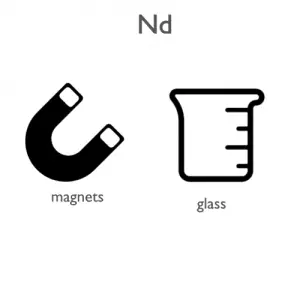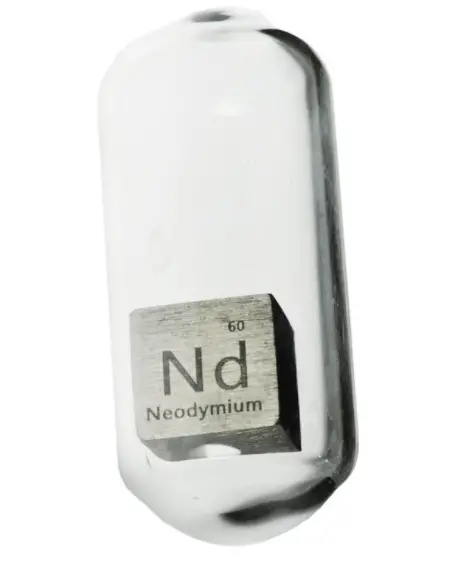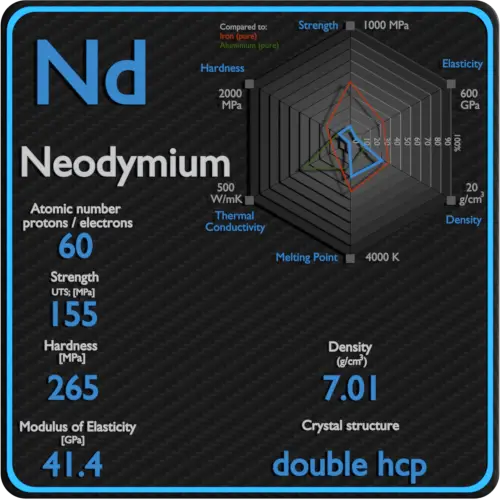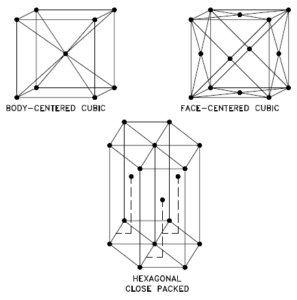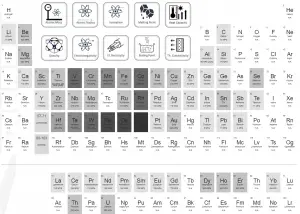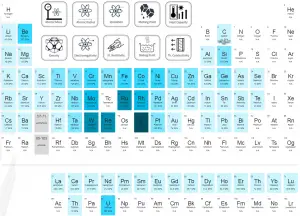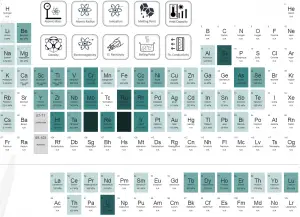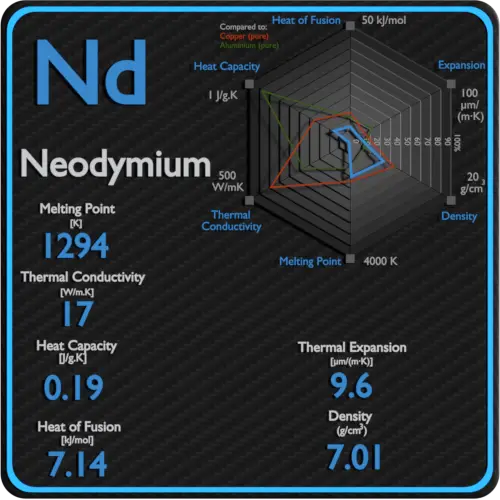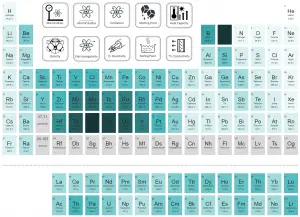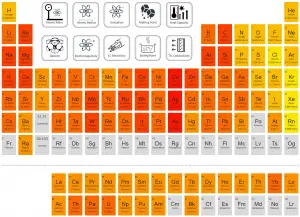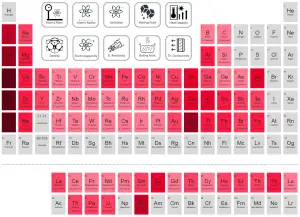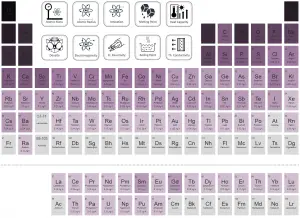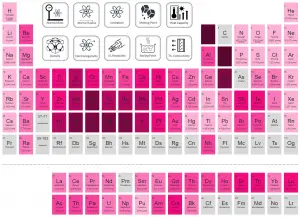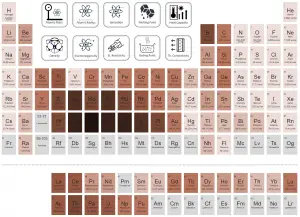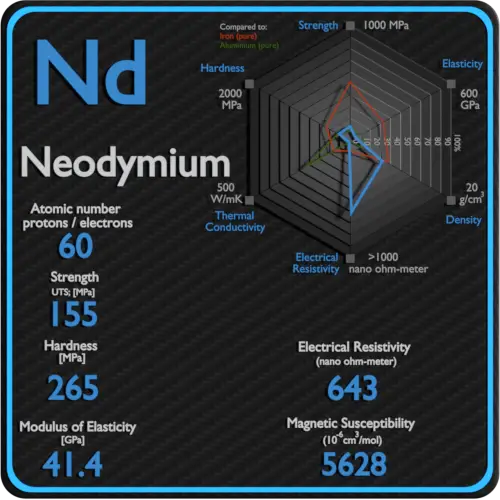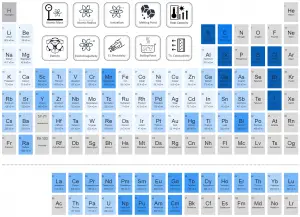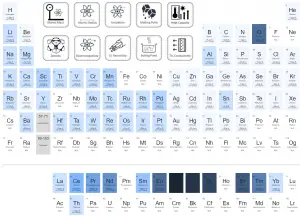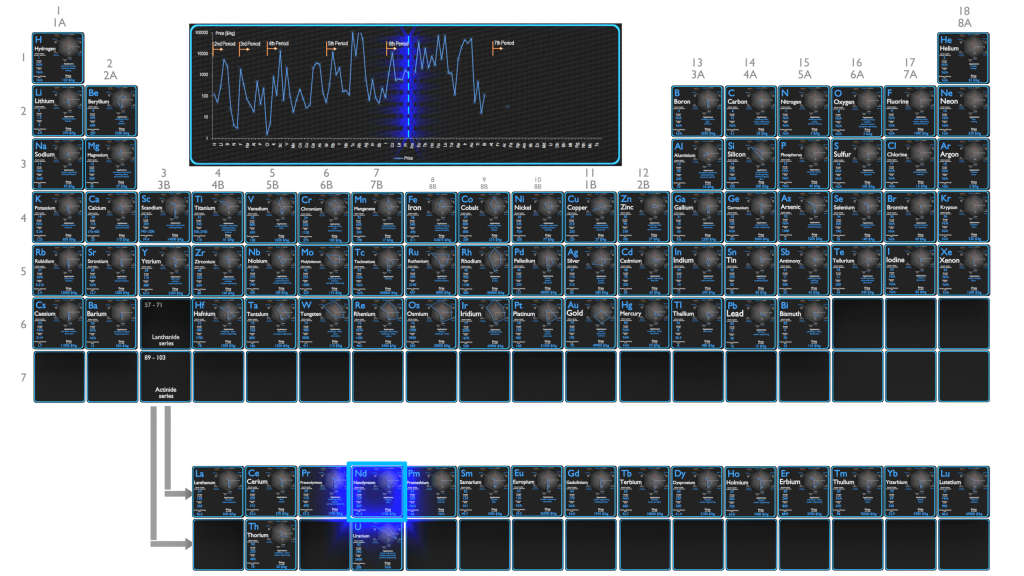About Neodymium
Neodymium is a soft silvery metal that tarnishes in air. Neodymium is not found naturally in metallic form or unmixed with other lanthanides, and it is usually refined for general use. Although neodymium is classed as a rare earth, it is a fairly common element.
Summary
| Element | Neodymium |
| Atomic number | 60 |
| Element category | Rare Earth Metal |
| Phase at STP | Solid |
| Density | 7.01 g/cm3 |
| Ultimate Tensile Strength | 155 MPa |
| Yield Strength | 150 MPa |
| Young’s Modulus of Elasticity | 41.4 GPa |
| Mohs Scale | N/A |
| Brinell Hardness | 265 MPa |
| Vickers Hardness | 350 MPa |
| Melting Point | 1016 °C |
| Boiling Point | 3074 °C |
| Thermal Conductivity | 17 W/mK |
| Thermal Expansion Coefficient | 9.6 µm/mK |
| Specific Heat | 0.19 J/g K |
| Heat of Fusion | 7.14 kJ/mol |
| Heat of Vaporization | 273 kJ/mol |
| Electrical resistivity [nanoOhm meter] | 643 |
| Magnetic Susceptibility | +5628e-6 cm^3/mol |
Applications of Neodymium
The most important use for neodymium is in an alloy with iron and boron to make very strong permanent magnets. These magnets are widely used in such products as microphones, professional loudspeakers, in-ear headphones, high performance hobby DC electric motors, and computer hard disks, where low magnet mass (or volume) or strong magnetic fields are required. Larger neodymium magnets are used in high-power-versus-weight electric motors (for example in hybrid cars) and generators (for example aircraft and wind turbine electric generators). Neodymium is a component, along with praseodymium, of didymium glass. This is a special glass for goggles used during glass blowing and welding. The element colours glass delicate shades of violet, wine-red and grey. Neodymium is also used in the glass for tanning booths, since it transmits the tanning UV rays but not the heating infrared rays.
Production and Price of Neodymium
Raw materials prices change daily. They are primarily driven by supply, demand and energy prices. In 2019, prices of pure Neodymium were at around 1100 $/kg.
Commercially, it is recovered from monazite sand and bastnasite by extraction processes and ion exchange techniques. Monazite is an important ore for thorium, lanthanum, and cerium. It is often found in placer deposits. India, Madagascar, and South Africa have large deposits of monazite sands. The deposits in India are particularly rich in monazite. The world’s production of neodymium was about 7,000 tonnes in 2004.
Source: www.luciteria.com
Mechanical Properties of Neodymium
Strength of Neodymium
In mechanics of materials, the strength of a material is its ability to withstand an applied load without failure or plastic deformation. Strength of materials basically considers the relationship between the external loads applied to a material and the resulting deformation or change in material dimensions. In designing structures and machines, it is important to consider these factors, in order that the material selected will have adequate strength to resist applied loads or forces and retain its original shape. Strength of a material is its ability to withstand this applied load without failure or plastic deformation.
For tensile stress, the capacity of a material or structure to withstand loads tending to elongate is known as ultimate tensile strength (UTS). Yield strength or yield stress is the material property defined as the stress at which a material begins to deform plastically whereas yield point is the point where nonlinear (elastic + plastic) deformation begins.
See also: Strength of Materials
Ultimate Tensile Strength of Neodymium
Ultimate tensile strength of Neodymium is 155 MPa.
Yield Strength of Neodymium
Yield strength of Neodymium is 150 MPa.
Modulus of Elasticity of Neodymium
The Young’s modulus of elasticity of Neodymium is 150 MPa.
Hardness of Neodymium
In materials science, hardness is the ability to withstand surface indentation (localized plastic deformation) and scratching. Brinell hardness test is one of indentation hardness tests, that has been developed for hardness testing. In Brinell tests, a hard, spherical indenter is forced under a specific load into the surface of the metal to be tested.
Brinell hardness of Neodymium is approximately 265 MPa.
The Vickers hardness test method was developed by Robert L. Smith and George E. Sandland at Vickers Ltd as an alternative to the Brinell method to measure the hardness of materials. The Vickers hardness test method can be also used as a microhardness test method, which is mostly used for small parts, thin sections, or case depth work.
Vickers hardness of Neodymium is approximately 350 MPa.
Scratch hardness is the measure of how resistant a sample is to permanent plastic deformation due to friction from a sharp object. The most common scale for this qualitative test is Mohs scale, which is used in mineralogy. The Mohs scale of mineral hardness is based on the ability of one natural sample of mineral to scratch another mineral visibly.
Neodymium is has a hardness of approximately N/A.
See also: Hardness of Materials
Neodymium – Crystal Structure
A possible crystal structure of Neodymium is double hexagonal close-packed structure.
In metals, and in many other solids, the atoms are arranged in regular arrays called crystals. A crystal lattice is a repeating pattern of mathematical points that extends throughout space. The forces of chemical bonding causes this repetition. It is this repeated pattern which control properties like strength, ductility, density, conductivity (property of conducting or transmitting heat, electricity, etc.), and shape. There are 14 general types of such patterns known as Bravais lattices.
See also: Crystal Structure of Materials
Crystal Structure of Neodymium
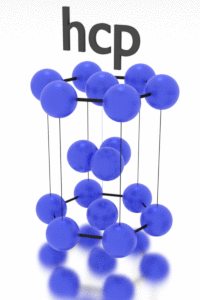
Thermal Properties of Neodymium
Neodymium – Melting Point and Boiling Point
Melting point of Neodymium is 1016°C.
Boiling point of Neodymium is 3074°C.
Note that, these points are associated with the standard atmospheric pressure.
Neodymium – Thermal Conductivity
Thermal conductivity of Neodymium is 17 W/(m·K).
The heat transfer characteristics of a solid material are measured by a property called the thermal conductivity, k (or λ), measured in W/m.K. It is a measure of a substance’s ability to transfer heat through a material by conduction. Note that Fourier’s law applies for all matter, regardless of its state (solid, liquid, or gas), therefore, it is also defined for liquids and gases.
Coefficient of Thermal Expansion of Neodymium
Linear thermal expansion coefficient of Neodymium is 9.6 µm/(m·K)
Thermal expansion is generally the tendency of matter to change its dimensions in response to a change in temperature. It is usually expressed as a fractional change in length or volume per unit temperature change.
Neodymium – Specific Heat, Latent Heat of Fusion, Latent Heat of Vaporization
Specific heat of Neodymium is 0.19 J/g K.
Heat capacity is an extensive property of matter, meaning it is proportional to the size of the system. Heat capacity C has the unit of energy per degree or energy per kelvin. When expressing the same phenomenon as an intensive property, the heat capacity is divided by the amount of substance, mass, or volume, thus the quantity is independent of the size or extent of the sample.
Latent Heat of Fusion of Neodymium is 7.14 kJ/mol.
Latent Heat of Vaporization of Neodymium is 273 kJ/mol.
Latent heat is the amount of heat added to or removed from a substance to produce a change in phase. This energy breaks down the intermolecular attractive forces, and also must provide the energy necessary to expand the gas (the pΔV work). When latent heat is added, no temperature change occurs. The enthalpy of vaporization is a function of the pressure at which that transformation takes place.
Neodymium – Electrical Resistivity – Magnetic Susceptibility
Electrical property refers to the response of a material to an applied electric field. One of the principal characteristics of materials is their ability (or lack of ability) to conduct electrical current. Indeed, materials are classified by this property, that is, they are divided into conductors, semiconductors, and nonconductors.
See also: Electrical Properties
Magnetic property refers to the response of a material to an applied magnetic field. The macroscopic magnetic properties of a material are a consequence of interactions between an external magnetic field and the magnetic dipole moments of the constituent atoms. Different materials react to the application of magnetic field differently.
See also: Magnetic Properties
Electrical Resistivity of Neodymium
Electrical resistivity of Neodymium is 643 nΩ⋅m.
Electrical conductivity and its converse, electrical resistivity, is a fundamental property of a material that quantifies how Neodymium conducts the flow of electric current. Electrical conductivity or specific conductance is the reciprocal of electrical resistivity.
Magnetic Susceptibility of Neodymium
Magnetic susceptibility of Neodymium is +5628e-6 cm^3/mol.
In electromagnetism, magnetic susceptibility is the measure of the magnetization of a substance. Magnetic susceptibility is a dimensionless proportionality factor that indicates the degree of magnetization of Neodymium in response to an applied magnetic field.

